SAP HANA – The Business Future
Category: SAP HANA Posted:May 29, 2017 By: Ashley Morrison
There is no doubt that an open source solution doesn’t yet exist which can stand toe to toe with SAP HANA as of today. And it is clear that HANA adds greatly to the value of SAP and its customer’s products, especially when it is used as a component of a solution such as S/4HANA, BW, Hybris and a whole lot more. Open source technologies such as Hadoop complements HANA and HANA in turn offers seamless interfaces to such solutions. Large scale enterprises are hesitant when it comes to adoption of SAP HANA since most business or enterprise applications are critical in nature, and when this is the case, support assumes first priority. Supports holding the paramount importance that it does, enterprises in turn think twice before leaving their revenue generating business applications to chance in terms of consistent and extended support.
But this is where HANA offering from SAP steps in with its reliable support- so much so, that SAP has guaranteed reliable product support until the year 2025. This gives its customer and client plenty of time to upgrade to the superior S/4HANA and other popular HANA products which are equally in demand by enterprises ranging from start-ups to large corporations. Products such as BW or even applications for that matter like POS will find it profitable and making great sense to shift to HANA sooner than later. Thus moving from an initially established and accepted row-based memory database too one that is column based. This can lead to accelerated applications, saves disk space and also cuts down on maintenance.
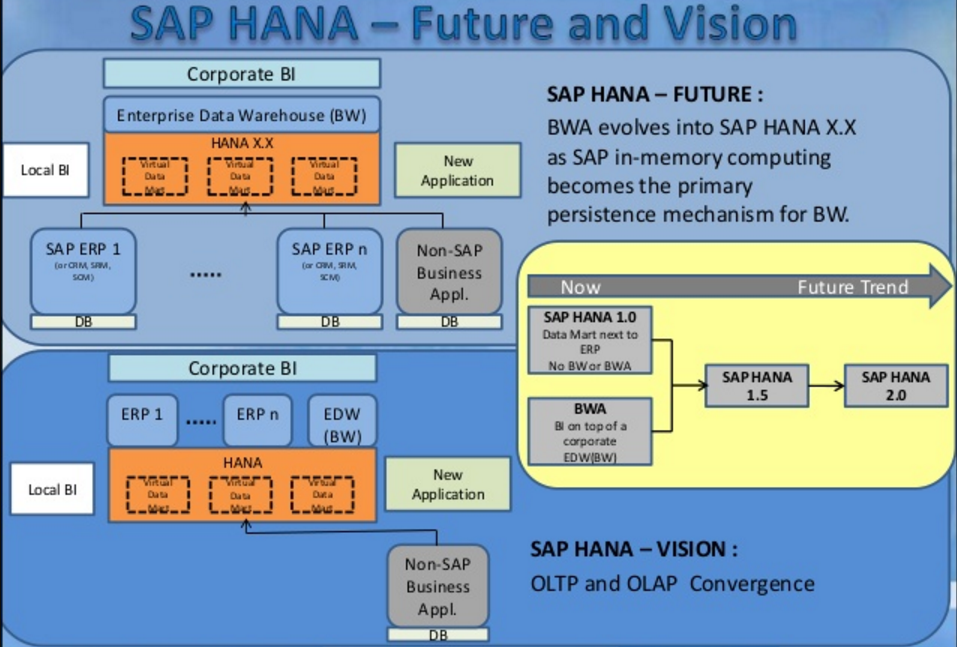
Source:image.slidesharecdn.com
Being an impressive initiative on the behalf of SAP, it unifies the enterprise around a singular vision which has, in turn enabled SAP to streamline its products as a great deal.
It is worth noting that S/4 and HANA together have given SAP its second wind in terms of chances to compete and advance its cause in advanced technology applications.
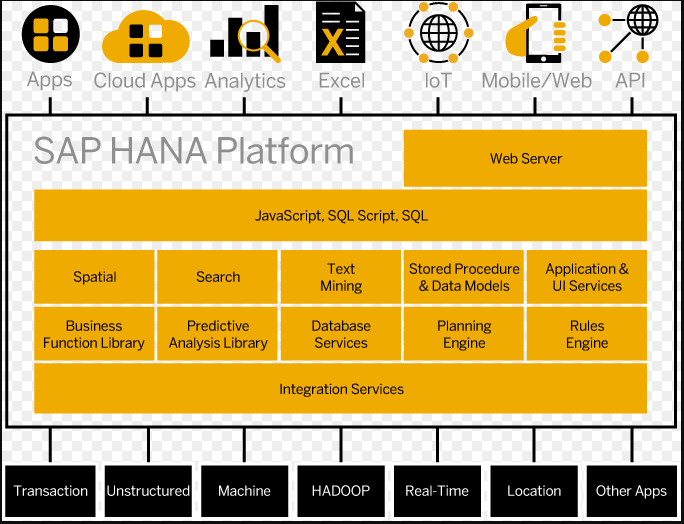 Source:www.sap.com
Source:www.sap.com
Conventional technology enterprises are set back by innovator issues such as when early success with respect to general product innovation brings about complacency preventing updations, overhauling and further detailed innovations. This is where SAP differs from conventional IT corporations by risking quite a lot of resources by going a different way with HANA and Fiori. SAP has adopted a far more open approach according to market insiders when it comes to product development and deployment. As consumers and fellow competing organisations can simultaneously see, the bet is paying off with significant dividends. Since the SAP deployments are highly complicated with several iterations and processes involved in breathing life into SAP solutions in the field, it is bound to take a longer time than it would have taken if it was a simpler product offering lesser solutions.
Learn SAP HANA from Industry Experts
Future of BI and SAP HANA
With Business Intelligence no longer being restricted to report generation, it currently occupies the pole position in the priority list of IT strategy within enterprises. Where an organization stands in terms of maturity in their particular BI implementation path depends upon how the enterprises have evolved through their business. But, surprisingly enough, this does not mean that all BI initiatives instituted today may not necessarily be effective.

Source:blogs.sap.com
This would mostly depend upon the treatment that BI initiatives receive from enterprises, along with the techniques of implementation involved. Organizations who have successfully implemented their BI foundation will next look to progress on to the next level of maturity, with most questions being asked only in terms of additional capabilities.
Exploring the future of SAP HANA
SAP services are looking well into the future in terms of capabilities which are customized according to the particular industry and vertical using SAP HANA. Real-time analysis for product compliance, global batch traceability, Genome sequencing, and flexible margins also suitable for products with volatile raw material prices are just a few of the applications that are being revolutionised by the immense power of SAP HANA.
 Source:media.licdn.com
Source:media.licdn.com
SAP HANA allows for simple and convenient process change with an integration of capabilities required for special case scenarios. Irrespective of whether your pharmaceutical business requires overseeing, analysing, and evaluating complex test data series, or even if your chemicals company needs to react instantly to rapidly changing raw material environments, SAP HANA can handle the workload with ease. This also includes scientific text data analysis.
The official release of the SAP HANA database as the prime database for the SAP Business Suite software enables transactional processes to speed up along with analytical process steps to be integrated seamlessly into daily work.
SAP HANA and the Future of Supply Chain Planning
The fact that data flow increases exponentially within a short period of time is not a new-fangled notion. Enhanced forecasting, on-demand analytics, and supply chain planning all require a refined approach to capture and leveraging of data for desired outputs.
While in-memory computing is an impressive feature which has several applications across several industry verticals, it is still to be proven in the field of Supply Chain Management.
There are innumerable candidates for data management of the next generation- meant for SCM these include but are not limited to HANA, Oracle, Microsoft and also Demand Signal Repositories or DSRs.
 Source:just-bi.nl
Source:just-bi.nl
An enterprise named ToolsGroup has moved forward across various fronts such as a partnership with Retail Velocity which is a leading DSR. It also includes certified interfaces with SAP ERPs on the HANA platform. The goal at ToolsGroup is a seamless integration of supply chain planning along with software optimization which is a leading DSR. It also includes certified interfaces with SAP ERPs on the HANA platform. The goal at ToolsGroup is a seamless integration of its supply chain planning along with optimization software together with large data repositories of prospective valuable demand and supply chain data. This will in turn reduce dataflow latency while allowing high-frequency re-planning and optimization using real-time data.
As per Gartner a well-known market research company, SAP has already been seen commercializing HANA for the supply chain as stated by the well-known market research company Gartner. He says this can be achieved through the consolidation of Cloud, mobile, in-memory computing and also considering the scale and speed of the same.
The objective here was to allow users to access and analyse analytical and transactional data in real-time to accelerate decision making.
But the approach and timelines of this effort have raised questions amongst the organizations and users. Lora Cecere, Founder and CEO of Supply Chain Insights which is an LLC dealing with Supply Chain derived insights. She says that SAP HANA is seen by the LLC as a solution for enhancing the scale of transactional systems of reference like ERP. Cecere does not see it as the foundation of future analytics because she believes there is a further need for data which isn’t structured and transactional which can prove to be a problem for HANA.
While planning data is frequently time-phased with sensor data such as the Internet of Things (IoT) and RFID representing streaming and even time-phased data. Cecere goes on to say while HANA might not be the ideal structure for streaming and time-phased data, there are limitless possibilities for the utilization of social data images, warranty information, GPS data and a whole lot more. The future of supply chain management lies within unstructured data.
When SAP’s new Chief Information Officer Bernd Leukert announced SAP’s plan to rework HANA in 2014, the E3 tech magazine suggested customers not to run SAP HANA platform by themselves. As a reaction to this statement, the co-CEO of the organization named DataVard, Goetz Lessmann spoke out against the magazine’s statement. DataVard aids customers globally in the migration to SAP HANA.
Goetze said the fact remains that accurate HANA implementation and migration to HANA itself will require higher levels of effort when compared to a fundamental OS or DB migration. However, this is independent of cloud/hosting or on-premise. The cause for this is that adaptations of data models and system operations are needed to use the modern in-memory tech, thus making the system forward compatible. Many such adaptations would be needed in any case for implementation of upgrades.
SAP and their partners provide consulting tools and services in order to support migrations and also continue running HANA in cost-effective ways. A great place to start among others would be to dive deep into SAP SLO portfolio along with the solution “Road to HANA” which is provided along with SAP.
The generic thumb rule is that data should be stored and utilized in line with its value. SAP has begun a new era in data processing with the highly innovative in-memory technology of SAP HANA. Alongside alight scepticism regarding the future of HANA, most market experts have declared that database technology enhances the operation of massive SAP systems at one end and provides brand new application scenarios on the other. This is bound to bring a large set of benefits to SAP’s existing and prospective customers with SAP’s decision to re-work HANA not affecting the fundamental truth about the effectiveness of HANA
Register for live webinar on SAP HANA by Industry Experts
Advantages
It is a fact that most SAP customers can’t grasp the possibilities that are offered by SAP HANA as a database and how this can aid in the optimization of business processes. The only exception here is that in the context of ERP, HANA can help in a few special scenarios only, through the application of the in-memory technology.
The applications referred to in terms of ERP is LIS, CO-PA reporting and also elaborate running processes such as MRP running in ERP and payroll in HR and more. More often than not, ERP processes and modules both still require optimization for HANA. The complete potential of HANA is yet to be realized on several levels. But when it comes to Business Warehousing, this is basically different. A convenient 1:1 migration of classic databases to HANA can bring about measurable enhancements in system performance. But, in the case of a bad data model, it will obviously not be transformed into a highly efficient one.
While migration can prove to be a quick fix, acting as the first step to making instant progress in terms of performance and system operations, this should not be the end game. A migration should always be accompanied by housekeeping and Nearline storage or NLS along with systemic code-optimization and system monitoring. An independent migration to HANA will only work as a temporary fix without any long-term benefits, and may even lead to disadvantages in the long-run.
Even though SAP sometimes find it difficult to justify the need for existing customers to migrate to HANA, The raw technological value inherent in HANA and its ability to respond to, and resolve industry-specific use cases have the ability to display clear and measurable value in an intuitive manner and also in a very short duration of time.
SAP HANA’s conglomerate of engines- challenges
While SAP HANA is known to combine multiple engines, customer experience with HANA migrations have repeatedly and consistently shown that this does not usually present a problem or any set of issues for enterprises shifting to HANA. The reason for this is that when organizations are utilizing HANA as a database, such engines are either not visible or form a component of a black box.
As an analogy to the above statement, even legacy databases comprise of several components which are not visible or poorly visible to users or developers, especially if the access is achieved through SQL. In the end, it is a known fact that the users will be unaware of how the Oracle-Optimizer works or how Oracle runs just-in-time precompiled PL-SQL scripts.
When considering Business Warehouse and ERP, the benefits of SAP HANA as SQL-database with in-memory technology will counter any forecasted disadvantages. It is also an established fact that the sheer number of engines within HANA does not necessarily mean that it will become impossible to maintain. The subject of maintenance has always been regarded as a challenge for SAP as a vendor. But it is important to remember that SAP is responsible for the maintenance and development of the ERP suite from decades since, even though the suite is composed of various engines, which in this case are called modules.
Simplicity in use as a database
SAP HANA is found to be simple to run as replacement of a legacy database when utilized for data warehouses. What’s more, SAP customers do not require a group of special engines or the HANA studio to accomplish all this. The whole set of BW area SAP customers can gain from this particular feature – beginning with performance enhancements along with the flexibility for reporting this brings about.
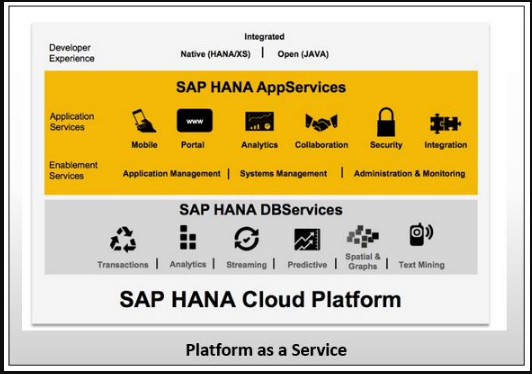 Source:media.licdn.com
Source:media.licdn.com
When analysing costs, this can be considered as an initial investment. SAP Customers frequently combine this with IT landscape overhauls or projects which were planned in the first place. There is a myth prevalent among IT enterprise circles about HANA being expensive, but this is because such enterprises try to integrate and “stuff” other existing projects into a particular instance of HANA migration. Such overdue projects range from process changes, outsourcing, Unicode, archiving/NLS, upgrades, harmonisations, and system consolidations. This is what transforms HANA migrations into a long-running tedious and expensive activity.
On-premise as an alternative
One has to remember that SAP HANA does not have to be expensive or even hard to run on premise. Customers who have decided to run HANA in their very own data-centers will indeed have complete control. While hosting or Cloud can make sense, it needs validation in light of Service Level Agreement defined in the contract or the complete contract itself. Most customers are initially swayed by the apparent cost-effective nature of hosting models, they do not realize the costs that come up when services not mentioned in the contract are needed. These costs can turn out to be quite expensive. Some such common costs include the changing of hosting partners. This means that migrations between data-centres lead to process changes which come along with additional costs. And this holds true for both HANA in the cloud, as well as conventional hosting solutions.
Adequate preparation required for Success
During the preparations for a migration, it is of paramount importance to clarify the data that is to be utilized in real time with SAP HANA. If an enterprise wants to leverage real-time reporting, it would need an intelligent data management to ensure data quality, performance, and even storage. Most enterprises will find the first step to weigh heavily on their resources as it stands today. The reason for this is the complex nature of the underlying data models along with massive data volume sizes. Hence it is hard to execute valid proof of concept for data migration. To support this, SAP partners provide specialized analysis services to aid customers in determining the true value of data with relation to data volume, granularity, and frequency of data access.
Another efficient approach to survive a HANA migration is to undertake a selective migration which allows for cost-efficient migrations in SAP HANA with minimized system sizes. Most SAP customers can easily stand to gain from a step-wise selective migration.
The first step to a hassle-free migration is the recognition of central use cases. Post which a design integrating all data layers is required to be created.
Conclusion
While SAP HANA may not exactly be the universal solution to every problem imaginable, it is lightning fast, bringing along with it several advantages for special scenarios. Enterprises should always consider the value of their data in the context of spiking infrastructure costs. If organizations are looking to harness the full power of HANA, they will first need to decide the data worth to be kept in for real-time access. With the subjects of data management and Information Lifecycle Management transforming into core IT strategy fields, SAP HANA is definitely the future of all things enterprise.
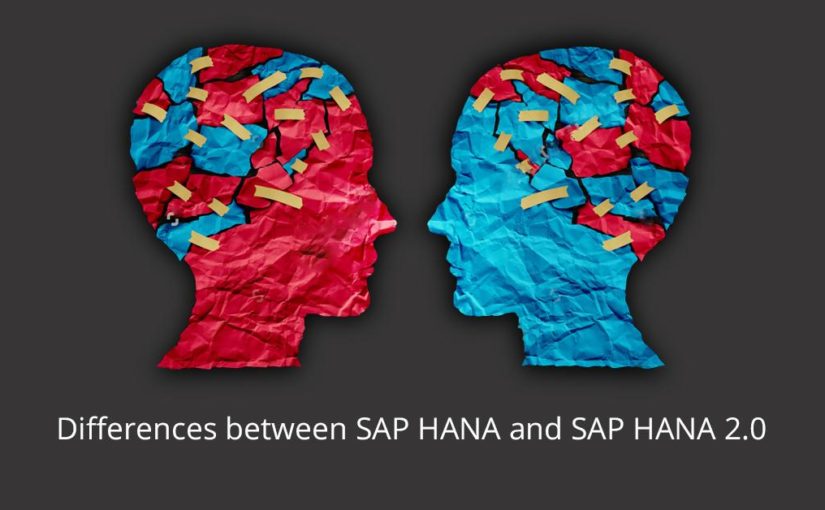

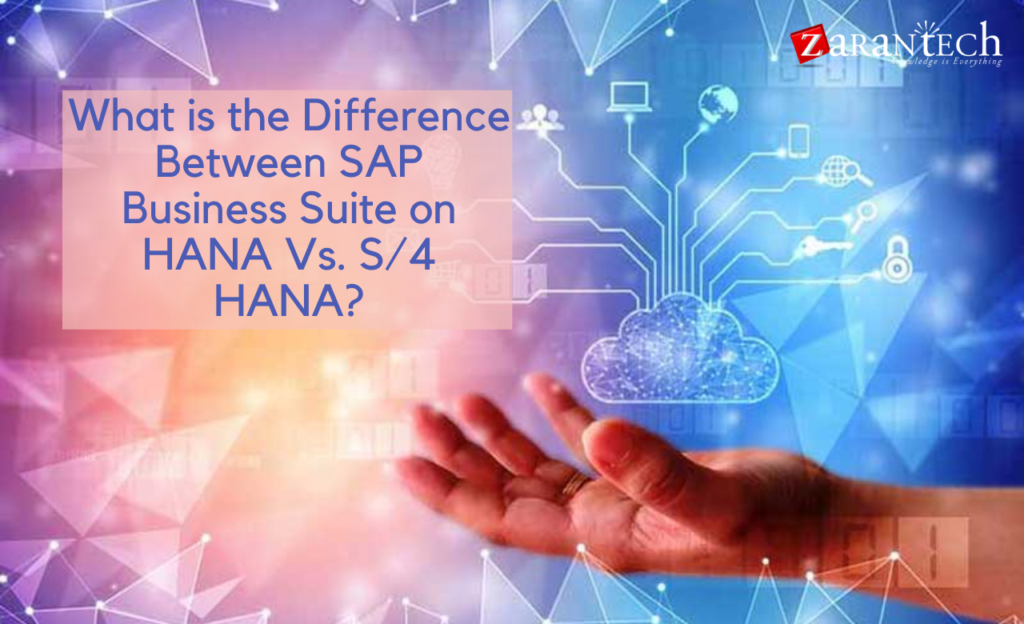

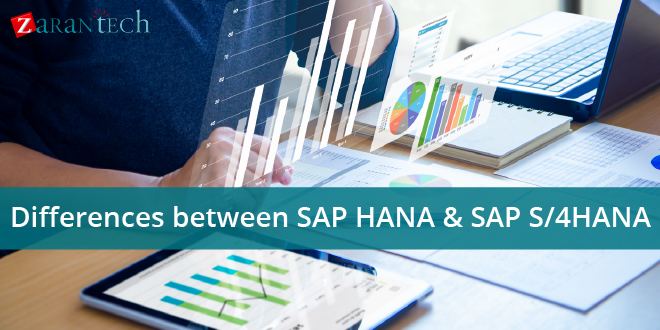
 99999999 (Toll Free)
99999999 (Toll Free)  +91 9999999
+91 9999999